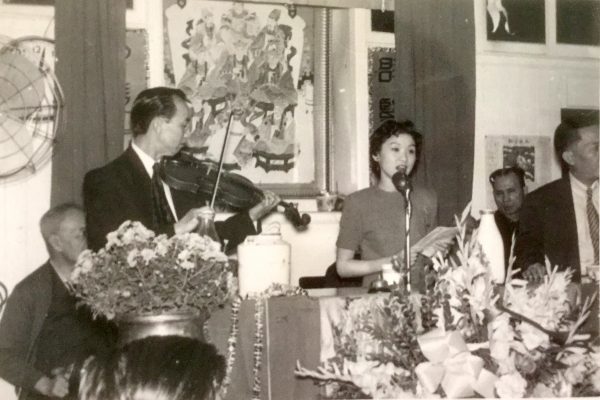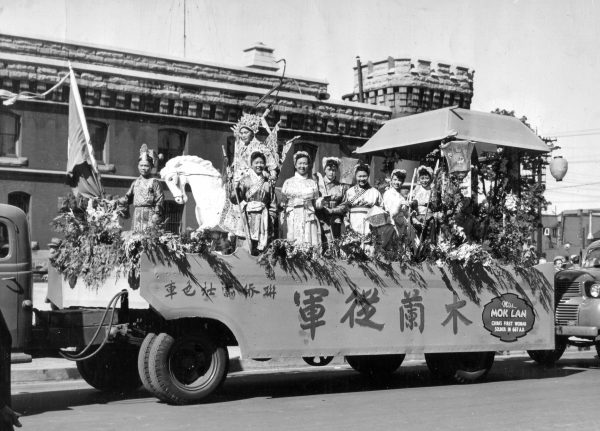Cantonese opera is in my genes. Whenever my mother put me and my two younger sisters down for our afternoon nap, she’d crank up the turntable and play an eclectic range of recordings. I listened to classical music, tunes from Rodgers and Hammerstein musicals, and Cantonese opera. The recent symposium, “Stories, Struggles and Song: Cantonese Opera in Toronto,” at the Richard Charles Lee Canada-Hong Kong Library, conjured up a flood of memories.
Developed over the course of 300 years, Cantonese opera features folk and historical stories that are dramatized with music, high-pitched falsetto singing, elaborate face painting, glamorous costumes, martial arts, acting, and acrobatics. These operas were not geared to elite audiences, but rather had a mass appeal as a treasured cultural pastime, particularly in the Cantonese-speaking villages of southern China, the place of origin of most early Chinese immigrants to North America.
Brought to Canada in the 1850s, Cantonese opera was central and vital to the cultural life of the Chinese community. This was the era of the so-called bachelor society, when the ratio of Chinese men to women, at its worst, was 280 to one. The extreme gender imbalance was the result of head taxes levied on Chinese immigrants from 1885 to 1923 that made it too expensive for men to bring their wives and children to Canada. The 1923 Chinese Immigration Act, in turn, banned virtually all Chinese immigration until 1947. There were few women, children, and families.
Within a short time, opera flourished in Vancouver and Victoria where Chinese audiences flocked to specially-built theatres, one large enough to seat 800 people. For four to five hours, the opera-goers were transported back to their homeland, escaping the daily drudgery of work, the unrelenting anti-Chinese discrimination, and the painful absence of their beloved families. As student Nina Zhou explained, “It [was] one of the few recreations available to Chinese immigrants in their spare time.” Cantonese opera provided “a hub for many early immigrants expressing their nostalgic longing for the homeland, as a way of preserving their own cultural identity, and as a relief from discrimination and exclusion in a totally strange and new cultural environment.”
With the support of the Shirley Hune 許佩娟 Chinese Canadian Oral History Fund, the significance of this music in Toronto’s early Chinese Canadian community is being studied in the University College Chinese Canadian Studies program under Professor Lisa Mar and research students Jonathan Wu, Nina Zhou, Ailin Lin, and Danielle Lim, who shared their findings from the oral history and archival material about this topic.
A primary resource is the sizeable Beatrice and Raymond Jai Collection, donated by their daughter Julie Jai. Her parents played an important role in the development of Cantonese opera in Vancouver and Toronto. Their photos, manuscripts, musical scores, performance programs, recordings, and other archival material, amassed from the 1930s to the ’90s, will be an important part of U of T’s newly launched Chinese Canadian Archive.

Cantonese opera slowly spread across Canada as the Chinese people moved eastwards from British Columbia. In Toronto, the first recorded performance took place in 1916; the first Chinese music group, World Mirror, was established in 1919. By 1935, there were three music clubs in Chinatown, including the Chinese United Dramatic Society and the Ship Toy Yuen Dramatic Society, both still active today. They not only fostered Cantonese opera by training local amateurs, but also by sponsoring touring groups from Hong Kong and China. Like the associations whose members shared a common surname or birthplace, these music clubs functioned as mutual benefit organizations. They provided welfare, employment, housing, financial, and other indispensable supports in the absence of settlement services that are in abundance today.
In Cantonese opera tradition, there were only male actors, some of whom played female roles. Even though mixed troupes became commonplace in Hong Kong and China by the 1930s, music clubs across Canada had to rely on men to play both male and female roles during the bachelor society years. My father, Doyle Lumb, arrived from China in the mid-1920s as Toronto’s music clubs were being established. He worked long hours at a restaurant and spent his days off, learning to sing, act, and play instruments. With his good looks, my father was readily recruited for female roles.
The Chinese United Dramatic Society had a 250-seat hall at 98 Elizabeth Street, just south of Dundas Street, for its performances. Other clubs were resourceful in taking advantage of the Sunday closure of Toronto businesses on the “Lord’s Day.” The infamous burlesque Casino Theatre on Queen Street West was rented for Cantonese opera, my father among the amateur actors.
From 1935 to 1945, many of these stage performances took an active role in raising funds during the Great Depression and for the war relief efforts throughout the Sino-Japanese and Second World wars. Off stage, music clubs sponsored parade floats for fundraising and community events. Their opera costumes added colour and fanfare to the festivities. The grandest parade in Toronto’s Chinatown was held to celebrate V-J Day in 1945.

After the war, Chinatown’s most popular art form was almost forgotten. Music clubs became less active as their membership declined. In the 1970s, however, a revival of Cantonese opera began in earnest with the advent of opera films and television, as well as the influx of immigrants from Hong Kong, including fans and professional opera teachers.
Jai remembered these years as a time when Cantonese opera was the “wallpaper of her childhood.” She grew up listening, watching, and performing with her parents for their Yeit Hoy Cantonese Music Club in Chinatown. After her parents passed away, she found that going through their music archives helped her better understand her own identity. She appreciates her mother and father’s significance in history and their “immense talent and effort to help Cantonese opera flourish in an environment where Chinese people were not always a welcomed minority.” She added, “It’s gratifying to see the change now in terms of people starting to appreciate things that we thought were really not part of the mainstream and therefore not important when I was a child. The contribution of Chinese Canadian opera performers is an important part of the diverse cultural heritage of Canada.”
The historical significance of Cantonese opera reaches well beyond Canadian borders. In 2009, UNESCO recognized it as an Intangible Cultural Heritage of Humanity. Guangdong Province, Hong Kong, and Macao subsequently committed long-term resources to build on the knowledge and skills of this centuries-old art form that has been passed on from generation to generation.
The afternoon program at U of T was rounded off with a story, inspired by and loosely based on the life of Gar Yin Hune (née Deer). Bernice Hune is an arts educator and storyteller with a vast repertory of traditional Asian folklore and tales from Canada’s history. Her sister is the donor of the Shirley Hune 許佩娟 Chinese Canadian Oral History Fund. They are the daughters of Gar Yin Hune, who was an actress in a Cantonese opera troupe that toured Canada in the late 1930s. Due to the outbreak of the war and despite the Chinese Immigration Act, she was allowed to stay behind in Canada. Bernice Hune held the audience spellbound with “Shoes for Suyin,” a tale about a young opera performer who joins a touring company and arrives in Canada during the Chinese exclusionary period.
Cantonese opera lives on as a popular cultural heritage among Chinese people around the world and as a medium to learn and understand Chinese culture. U of T encourages community members to contribute more documentation and oral history for its Chinese Canadian Archive.
“There’s really not a lot written about it Cantonese opera in Toronto,” observed Jonathan Wu, a U of T research student and the moderator of the symposium. “There’s still much more to tell and discover.”




